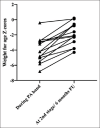Utility of late pulmonary artery banding in single-ventricle physiology: A mid-term follow-up
- PMID: 33679058
- PMCID: PMC7918013
- DOI: 10.4103/apc.APC_128_20
Utility of late pulmonary artery banding in single-ventricle physiology: A mid-term follow-up
Abstract
Background: The standard first stage palliation for univentricular heart with unrestricted pulmonary blood flow (PBF) is surgical pulmonary artery (PA) banding for which the ideal age is within the first 8 weeks of life. This study aimed to look for the utility of PA band done beyond 3 months of age for patients presenting beyond the stipulated period.
Materials and methods: This is a retrospective analysis of the outcome of twenty patients with single ventricle (SV) physiology with unrestricted PBF who presented late and were selected on the basis of clinical, radiological, and echocardiographic parameters for PA banding.
Results: The median age of the patients was 5.5 months (3.5-96 months), and the median body weight was 4.7 kg (3.2-22.0 kg). The patients were divided into three groups as follows: ten patients between 3 and 6 months of age (Group A), seven patients between 6 months to 1 year of age (Group B), and three patients > 1 year of age with additional features of pulmonary venous hypertension (Group C). The mean reduction of PA pressures following PA band was 60.9%, 48.8%, and 58.3% and the mean fall in oxygen saturation was 10.4%, 8.0%, and 6.6% in the three groups, respectively. The postoperative mortality rate was 10%. The mean follow up duration was 13.5 months (7-23 months). There was a statistically significant improvement in weight for age Z scores following PA band (P = 0.0001). On follow up cardiac catheterization, the mean PA pressures were 16.6 (±3.6), 22.7 (±5.7), and 33.3 (±12.4) mmHg, respectively, in the three groups, and the mean pulmonary vascular resistance index was 1.86 (±0.5), 2.45 (±0.7), and 3.5 (±1.6) WU.m2, respectively. Subsequently, seven patients in Group A, three patients in Group B, and one patient from Group C underwent successful bidirectional Glenn (BDG) surgery.
Conclusions: Late PA band in selected patients with SV physiology can have definite benefit in terms of correction of heart failure symptoms and subsequent conversion to BDG and can potentially change the natural history of disease both in terms of survival and quality of life.
Keywords: Late pulmonary artery band; pulmonary vascular disease; single ventricle; unrestrictive pulmonary blood flow.
Copyright: © 2020 Annals of Pediatric Cardiology.
Conflict of interest statement
There are no conflicts of interest.
Figures




Similar articles
-
Bidirectional glenn surgery without palliative pulmonary artery banding in univentricular heart with unrestricted pulmonary flow. Retrospective multicenter experience.J Cardiothorac Surg. 2024 Feb 6;19(1):67. doi: 10.1186/s13019-024-02572-7. J Cardiothorac Surg. 2024. PMID: 38321557 Free PMC article.
-
Utility of Conventional but Late Pulmonary Artery Banding in Complex Cyanotic Congenital Heart Disease in a Toddler - A Single Case Scenario.Cureus. 2023 Feb 25;15(2):e35452. doi: 10.7759/cureus.35452. eCollection 2023 Feb. Cureus. 2023. PMID: 36851945 Free PMC article.
-
Outcomes of Primary Bidirectional Glenn in Children with Single Ventricle Physiology and Increased Pulmonary Blood Flow.Heart Surg Forum. 2020 Nov 18;23(6):E850-E856. doi: 10.1532/hsf.3299. Heart Surg Forum. 2020. PMID: 33234193
-
Bidirectional Glenn followed by total cavopulmonary connection or primary total cavopulmonary connection?Eur J Cardiothorac Surg. 1997 Aug;12(2):177-83. doi: 10.1016/s1010-7940(97)00150-4. Eur J Cardiothorac Surg. 1997. PMID: 9288503
-
Conversion of prior univentricular repairs to septated circulation: Case selection, challenges, and outcomes.Indian J Thorac Cardiovasc Surg. 2021 Jan;37(Suppl 1):91-103. doi: 10.1007/s12055-020-00938-9. Epub 2020 Jul 1. Indian J Thorac Cardiovasc Surg. 2021. PMID: 33603287 Free PMC article. Review.
Cited by
-
Impact of Pulmonary Artery Banding in Patients with Congenital Heart Disease and Pulmonary Hypertension.Rev Cardiovasc Med. 2024 Jul 8;25(7):253. doi: 10.31083/j.rcm2507253. eCollection 2024 Jul. Rev Cardiovasc Med. 2024. PMID: 39139432 Free PMC article.
-
Annals of Pediatric Cardiology: A new look and a new outlook.Ann Pediatr Cardiol. 2023 Jan-Feb;16(1):1-3. doi: 10.4103/apc.apc_38_23. Epub 2023 Apr 4. Ann Pediatr Cardiol. 2023. PMID: 37287844 Free PMC article. No abstract available.
-
Late presentation of congenital heart diseases in low- and middle-income countries: impact on outcomes.Indian J Thorac Cardiovasc Surg. 2025 Jun;41(6):704-717. doi: 10.1007/s12055-024-01771-0. Epub 2024 Jun 26. Indian J Thorac Cardiovasc Surg. 2025. PMID: 40417593 Review.
-
The single ventricle presenting late: surgical options.Indian J Thorac Cardiovasc Surg. 2025 Jun;41(6):745-755. doi: 10.1007/s12055-025-01948-1. Epub 2025 May 3. Indian J Thorac Cardiovasc Surg. 2025. PMID: 40417596 Review.
-
Presurgical Use of Hypoxic Mixture for Systemic Perfusion Improvement in Neonates With Complex Congenital Heart Disease: A Systematic Review and Meta-Analysis.Cureus. 2024 Feb 1;16(2):e53409. doi: 10.7759/cureus.53409. eCollection 2024 Feb. Cureus. 2024. PMID: 38435156 Free PMC article. Review.
References
-
- Rodefeld MD, Ruzmetov M, Schamberger MS, Girod DA, Turrentine MW, Brown JW. Staged surgical repair of functional single ventricle in infants with unobstructed pulmonary blood flow. Eur J Cardiothorac Surg. 2005;27:949–55. - PubMed
-
- Lee MG, Brizard CP, Galati JC, Iyengar AJ, Rakhra SS, Konstantinov IE, et al. Outcomes of patients born with single-ventricle physiology and aortic arch obstruction: The 26-year Melbourne experience. J Thorac Cardiovasc Surg. 2014;148:194–201. - PubMed
-
- Freedom RM, Benson LN, Smallhorn JF, Williams WG, Trusler GA, Rowe RD. Subaortic stenosis, the univentricular heart, and banding of the pulmonary artery: An analysis of the courses of 43 patients with univentricular heart palliated by pulmonary artery banding. Circulation. 1986;73:758–64. - PubMed
-
- Franklin RC, Spiegelhalter DJ, Anderson RH, Macartney FJ, Rossi Filho RI, Rigby ML, et al. Double-inlet ventricle presenting in infancy. II. Results of palliative operations. J Thorac Cardiovasc Surg. 1991;101:917–23. - PubMed
LinkOut - more resources
Full Text Sources
Other Literature Sources
